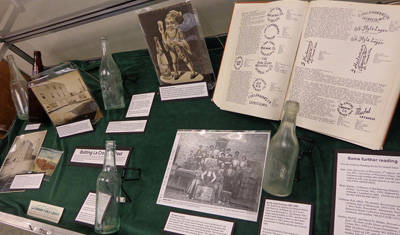
Refreshing Beverage, Anyone?
(written by David Kranz, Archives Staff)
La Crosse has a rich history of brewing – more than 15 breweries have tried to make a go of it here since the mid-1850s, some achieving national and international commercial success. During much of this time, breweries found glass bottles to be an economically smart way to transport and market their products, as did soft drink and mineral water suppliers.
We have antique bottles from some of La Crosse’s breweries and soda bottling companies on display through July 2014 at the LPL Archives.

Glass bottles were not always the container of choice for beer. Before pasteurization was incorporated into the brewing process, beer could go bad while in storage. Resulting pent-up gasses could cause containers to explode. There are various stories of even today’s hopeful home brewer heading to the cellar only to find an exploded container.
In those early days, crockery containers were preferred for small-batch storage, or wooden kegs if they were working on a larger scale. Some people didn’t store beer at all, just visited the local tap with a small pail or mug they would fill and carry home.
Even after pasteurization became a normal part of commercial brewing in the 1870s, there was still the challenge of how to keep the bottle closed. Various wired-down corks and other lids were tried before the “crown cap” was patented in 1892. Crown caps were adopted quickly by the bottling industry and were widely used by U.S. commercial brewers and bottlers by 1905. Today’s bottles still feature crown caps.
For crown caps to work, the tops of the bottles have to have a standardized shape and size. Believe it or not, for many years the bottom portions of bottles were formed separate from the tops. The two sections of hot glass were then joined, often leaving visible marks in the necks of the bottles. Bottle collectors have identified time periods when different bottle-making technologies were in general use.
Come in and view our display. We feature a particularly old bottle from the John Gund Brewing Co., plus bottles from C. & J. Michel Brewing Co. and G. Heileman Brewing Co. One came from the North Side Bottling Works, a soda and mineral water bottler and distributer founded in the 1890s – which in the 1920s transformed itself into the Orange Crush Bottling Co.
If old bottles or Wisconsin breweries are an interest of yours, come in and look at or check out some of these related books:
* Apps, Jerry. Breweries of Wisconsin. 2nd edition. Madison, Wis.: University of Wisconsin Press, 2005.
* Feldhaus, Ron, editor. The Bottles, Breweriana and Advertising Jugs of Minnesota, 1850-1920, Volume 1: Beer, Soda, Household. Minnesota: North Star Historical Bottle Collectors Association, 1986.
* Kroll, Wayne L. Badger Breweries: Past and Present. Jefferson, Wis.: Wayne L. Kroll, 1976.
* Kroll, Wayne L. Wisconsin Breweries and Their Bottles, 1840-1920. Jefferson, Wis., Wayne L. Kroll, 1972.
* Peters, Roger M. Wisconsin Soda Water Bottles, 1845-1910. 3rd ed. Madison, Wis.: Wild Goose Press, 1996.

